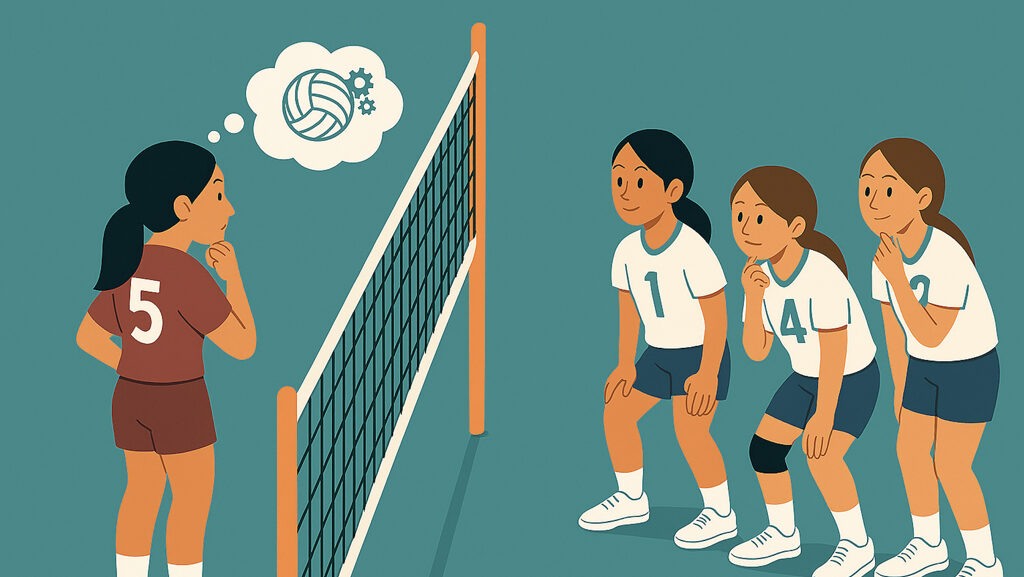The internet is overflowing with vast amounts of information, but so is the space beyond the volleyball net.
This article explores how players can develop crucial opponent court awareness skills.
Focus on Own Court
During practices with the elementary school team I coach, I try to create opportunities for team discussions before and after game-like drills. While I make every effort not to intervene and simply listen, I’ve recently noticed something worth discussing in this article.
Without being overly modest, I believe the players I coach possess exceptionally high verbalization skills. They can carry on detailed discussions without any prompting, which is truly remarkable.
Let me set aside praise for them and share my recent observations.
Here are some examples of their typical discussions:
“Let’s make sure to set high balls on the first touch.”
“We need to call for the ball early, before it arrives, so we know who’s taking it.”
“Let’s connect with three touches and attack.”
“Player A, you position there. I’ll set up here.”
Their discussions are specific and well-targeted. Such detailed verbalization is impressive.
However, something feels missing. There’s a sense of incompleteness that bothers me.
Awareness of the Opponent Court
Why would a coach demand more when players can already discuss so effectively among themselves?
Despite having such thoughts, I recognized that they need “something” to take the next step. Through this reflection, I noticed a common pattern in their discussions.
Most of their conversation content focuses on what happens on their own court.
Given volleyball’s competitive characteristics, this focus is natural. With the sport’s non-possession rules and the requirement that the ball cannot hit the ground, discussions naturally center on ball handling within their own court space.
However, volleyball is fundamentally a “competitive” sport.
Playing without awareness of opponents – the other court – won’t lead to genuine competitive improvement in the long term. Even if ball control skills improve significantly, inability to engage in strategic exchanges with opponents will result in losses as the competition level increases. Continuing to think only about their own half-court and playing “their volleyball” will eventually reach its limits.
For these players to advance further, they need to increase their attention ratio toward the opponent court.
Beyond the Net: A Wealth of Information
The opponent court – the space beyond the net – overflows with vast amounts of information.
This information includes player positioning and movement patterns, as well as gaps (spaces) that exist on the court. It might even include individual player expressions and breathing patterns. Much valuable information for winning games lies dormant beyond the net.
What I’ve written here represents common knowledge.
However, in reality, how many players and coaches effectively collect and utilize the abundant information available from the opponent court?
Probably not many.
Therefore, with self-reflection, I want to make it a habit to direct much more conscious attention toward the opponent court.
Practical Application for Development
This concept represents a crucial transition in volleyball development.
Moving from self-focused play to opponent-aware strategy marks the difference between recreational and competitive volleyball.
Coaching Applications:
Observation Drills: Create specific exercises where players must identify opponent positioning before making tactical decisions.
Information Processing: Teach players to quickly scan opponent formations during transitions and rally preparation.
Strategic Communication: Encourage players to include opponent analysis in their team discussions, not just their own court management.
Game Intelligence Development: Help young athletes understand that volleyball success requires constant information gathering and tactical adjustment based on opponent behavior.
This shift from internal focus to external awareness represents a fundamental evolution in volleyball intelligence that separates developing players from truly competitive ones.
Keywords: opponent court awareness, youth volleyball development, tactical awareness training, volleyball game intelligence, competitive volleyball strategy, volleyball observation skills, youth coaching methodology, advanced volleyball concepts


